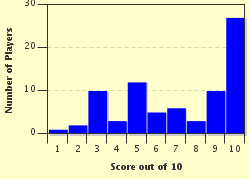Quiz Answer Key and Fun Facts
1. Some of the better known shorebirds are the plovers which comprise a separate family. To what family do these birds belong?
2. A number of plovers sport a black band around the neck or upper breast area but which North American species can be positively identified on account of having two black breast bands?
3. The Wilson's plover breeds from southern Alaska down the Pacific coast to northern California.
4. Sandpipers and plovers are both commonly found in wetland habitats. How does the shape of the bill differ between these two groups?
5. Which large and slender shorebird is easily identified during the breeding season by its long, upward curving bill and its orange/buff to pinkish neck and head?
6. Which of the following North American shorebirds has a downward curving bill?
7. What is the main difference between the lesser yellowlegs and the greater yellowlegs?
8. The black oystercatcher is, as the name suggests, a mostly black shorebird. It can be found along the Pacific coast. What color is its bill, making for a striking contrast to its black plumage?
9. Which family of shorebirds is classified as the Recurvirostridae?
10. How does the non-breeding plumage of the spotted sandpiper differ from the breeding plumage?
Source: Author
StetsonHat
This quiz was reviewed by FunTrivia editor
crisw before going online.
Any errors found in FunTrivia content are routinely corrected through our feedback system.

